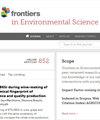Forest conservation as a CO2 offset measure: a case of an urban development project in Finland
IF 3.3
3区 环境科学与生态学
Q2 ENVIRONMENTAL SCIENCES
引用次数: 0
Abstract
This study investigates the carbon offset potential in Espoo, Finland, by comparing a construction-impacted deforestation site with a larger conserved forest area. Addressing a knowledge gap in localized forest conservation as a CO作为二氧化碳抵消措施的森林保护:芬兰城市发展项目案例
本研究通过比较一个受施工影响的森林砍伐地和一个面积较大的森林保护区,对芬兰埃斯波的碳补偿潜力进行了调查。为了弥补作为二氧化碳抵消方法的本地化森林保护方面的知识空白,我们的研究对两个研究地点的基准情景和替代情景下的碳储量和固碳影响进行了量化。抵消地点的基准情景反映了标准的森林管理实践,而替代情景则涉及完全的森林保护而不进行积极的管理。我们的研究结果表明,以挪威云杉(Picea abies)和苏格兰松树(Pinus sylvestris)为主的受保护森林(79 公顷)的土壤碳储量增加了 26 兆克碳/公顷,生物质碳储量增加了 65 兆克碳/公顷。这一增加足以弥补较小的毁林地(19 公顷)(也包含挪威云杉和苏格兰松)土壤中每公顷 186 兆克碳储量和生物量中每公顷 43 兆克碳储量的损失。此外,这项研究还揭示了二氧化碳补偿调节的复杂性,并强调了稳健、透明的碳核算实践的必要性。这些见解为将基于自然的解决方案纳入城市规划以实现更广泛的生态和气候目标提供了宝贵的视角。
本文章由计算机程序翻译,如有差异,请以英文原文为准。
求助全文
约1分钟内获得全文
求助全文
来源期刊

Frontiers in Environmental Science
Environmental Science-General Environmental Science
CiteScore
4.50
自引率
8.70%
发文量
2276
审稿时长
12 weeks
期刊介绍:
Our natural world is experiencing a state of rapid change unprecedented in the presence of humans. The changes affect virtually all physical, chemical and biological systems on Earth. The interaction of these systems leads to tipping points, feedbacks and amplification of effects. In virtually all cases, the causes of environmental change can be traced to human activity through either direct interventions as a consequence of pollution, or through global warming from greenhouse case emissions. Well-formulated and internationally-relevant policies to mitigate the change, or adapt to the consequences, that will ensure our ability to thrive in the coming decades are badly needed. Without proper understanding of the processes involved, and deep understanding of the likely impacts of bad decisions or inaction, the security of food, water and energy is a risk. Left unchecked shortages of these basic commodities will lead to migration, global geopolitical tension and conflict. This represents the major challenge of our time. We are the first generation to appreciate the problem and we will be judged in future by our ability to determine and take the action necessary. Appropriate knowledge of the condition of our natural world, appreciation of the changes occurring, and predictions of how the future will develop are requisite to the definition and implementation of solutions.
Frontiers in Environmental Science publishes research at the cutting edge of knowledge of our natural world and its various intersections with society. It bridges between the identification and measurement of change, comprehension of the processes responsible, and the measures needed to reduce their impact. Its aim is to assist the formulation of policies, by offering sound scientific evidence on environmental science, that will lead to a more inhabitable and sustainable world for the generations to come.
 求助内容:
求助内容: 应助结果提醒方式:
应助结果提醒方式:


